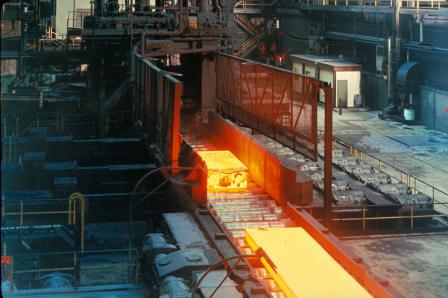Iron and Steel Manufacturing Effluent Guidelines
 EPA promulgated the Iron and Steel (I&S) Effluent Guidelines and Standards (40 CFR Part 420) in 1974, and amended the regulation in 1976, 1982, 1984, 2002 and 2005. The regulation covers any facility that is engaged in iron or steel manufacturing, forming, and finishing, including coke manufacturing. EPA estimates there are 254 iron and steel facilities discharging directly to surface waters or indirectly through publicly owned treatment works (POTWs).
EPA promulgated the Iron and Steel (I&S) Effluent Guidelines and Standards (40 CFR Part 420) in 1974, and amended the regulation in 1976, 1982, 1984, 2002 and 2005. The regulation covers any facility that is engaged in iron or steel manufacturing, forming, and finishing, including coke manufacturing. EPA estimates there are 254 iron and steel facilities discharging directly to surface waters or indirectly through publicly owned treatment works (POTWs).
The I&S Effluent Guidelines and Standards are incorporated into NPDES permits for direct dischargers or permits or other control mechanisms for indirect dischargers (see Pretreatment Program).
- What is the Iron and Steel Industry?
- Facilities Covered
- Related Category
- Rulemaking History
- Additional Information
What is the Iron and Steel Industry?
Iron and steel manufacturing processes include cokemaking, sintering, briquetting, ironmaking (including direct-reduced ironmaking), steelmaking, vacuum degassing, ladle metallurgy, casting, hot forming, forging, and finishing (e.g., acid pickling, descaling, cold forming, surface cleaning, hot coating and annealing).
Facilities Covered
- Cokemaking
- Sintering
- Ironmaking
- Steelmaking
- Vacuum Degassing
- Continuous Casting
- Hot Forming
- Salt Bath Descaling
- Acid Pickling
- Cold Forming
- Alkaline Cleaning
- Hot Coating
- Other Operations
(direct-reduced iron production, briquetting, forging)
- 3311: Iron and Steel Mills and Ferroalloy Manufacturing
- 3312: Steel Product Manufacturing from Purchased Steel
Note: the NAICS group listings are provided as a guide and do not define the coverage of the I&S category. For precise definitions of coverage, see the applicability sections in 40 CFR Part 420.
Related Category
Rulemaking History
2005 Amendment
EPA restored the provision that allows the use of alternative oil and grease limitations in NPDES permits (known as the “water bubble”) and corrected errors in the effective dates of NSPS
- Final Rule (December 13, 2005)
- Proposed Rule (August 10, 2005)
2002 Amendment
- Final Rule (October 17, 2002)
- Development Document
Industry description, wastewater characterization, treatment technologies, regulatory compliance cost estimates and pollutant loadings for the final rule - Economic Analysis
Economic impacts of the final rule and comparison with environmental impacts - Environmental Assessment
Environmental impacts of the final rule
- Development Document
- Correction notice (February 14, 2001)
- Proposed Rule (December 27, 2000)
1984 Amendment
- Documents, including:
- Final Rule (May 17, 1984)
- Proposed Rule (October 14, 1983)
- Final and Interim Final Rule (October 14, 1983)
1982 Amendment
- Final Rule (May 27, 1982)
- Development Document (EPA 440/1-82/024, May 1982)
Industry description, wastewater characterization, treatment technologies, regulatory compliance cost estimates and pollutant loadings for the final rule- Volume 1 (Overview, pollutants, technologies, costs, selection of BPT, BCT, BAT, NSPS, PSES and PSNS)
- Volume 2 (Coke Making, Sintering and Iron Making Subcategories)
- Volume 3 (Steel Making, Vacuum Degassing and Continuous Casting Subcategories)
- Volume 4 (Hot Forming Subcategory)
- Volume 5 (Salt Bath Descaling and Acid Pickling Subcategories)
- Volume 6 (Cold Forming, Alkaline Cleaning and Hot Coating Subcategories)
- Development Document (EPA 440/1-82/024, May 1982)
- Proposed Rule (January 7, 1981)
1976 Amendment
- Interim Final Rule (March 29, 1976)
1974 Initial Rulemaking
- Documents, including:
- Final Rule (June 28, 1974)
- Proposed Rule (February 19, 1974)
Additional Information
For additional information regarding Iron and Steel Effluent Guidelines, please contact Ahmar Siddiqui (siddiqui.ahmar@epa.gov) or 202-566-1044.
